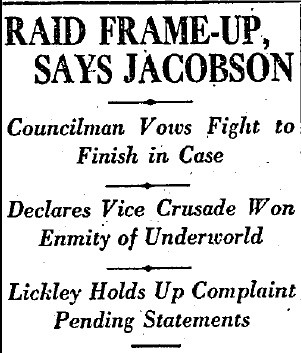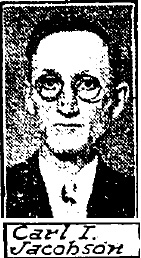
August 6, 1927
Los Angeles
Councilman Carl I. Jacobson was arrested in a morals raid at 4372 Beagle Street in the company of a woman who said her name was Mrs.  Hazel Ferguson, but who later admitted her real name was Mrs. Callie Grimes.
Hazel Ferguson, but who later admitted her real name was Mrs. Callie Grimes.
The married councilman insisted that he was framed and that the raid was the underworld’s retaliation for his much publicized crusade against vice in the city.
Jacobson, who lives in a small bungalow at 3014 Terry Place with his wife of thirty years, told cops that he had called upon Mrs. Ferguson to discuss a matter of street assessments with her. He said Mrs. Ferguson had telephoned him at his home and asked him to look over her property to see if it was worth paying the assessments.
When he arrived for their meeting Mrs. Ferguson poured two cocktails, and then moments later all of the lights in the house went out. It was then that police announced themselves and placed Councilman Jacobson and Mrs. Ferguson/Grimes under arrest.
The four arresting officers, Captains of Detectives Wallis and Williams, and Detectives Lucas and Raymond related a version of events substantively different from Jacobson’s account. They stated that they went to the Beagle street house, watched through a window and then observing what they felt constituted criminal behavior, crashed down a door to arrest the couple on morals violations. The arrest of Jacobson and Grimes begs the question: why were four high-ranking LAPD officers creeping around in the shrubbery with their noses pressed to a window like four Peeping Toms?
The case against Jacobsen would drag on. Jacobson would be tried twice on morals charges. In the first trial the jury would vote 9 to 3 for acquittal; in the second trial the jury would be evenly divided and the DA would decide against trying him for a third time. Mrs. Callie Grimes would confess to her part in the frame-up, and then recant. Grimes along with the four officers who conducted the raid would be tried for conspiracy, and the charges against them would be dismissed in 1929.
One of the detectives, Harry Raymond, would leave the LAPD and become a private investigator. He’d turn up again in the news as the victim of an attempted assassination by car bomb, in a 1938 corruption scandal involving Los Angeles Mayor Frank Shaw, members of his administration, and the LAPD.




